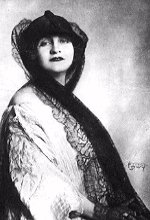ALMA MAHLER (1879-1964)

Alma was the daughter of the academic councilor and court painter
Jakob Emil Schindler (1842-1892). After his death, her mother Anna
married the painter Carl Moll (1861-1945), who has been her husband's
student. Alma studied composition under Alexander von Zemlinsky
and was in literary touch with the then director of the Burgtheater Max
Burghardt.
In November 1901, she met Gustav Mahler in a soiree at
the house of Berta and Emil Zuckerkandl. On March 9th
1902, the almost forty-two-year-old court opera director married the
nearly twenty-three-year-old Alma Maria Schindler at the Karlskirche
in Vienna. They had two daughters: Maria Anna (1902-1907) and Anna
Justina (1904-1988).
Mahler's circle of friends grew under Alma's influence. Now, the
companions of his youth (for instance the poet Siegfried Lipiner
or the musicologist Guido Adler) were joined by younger composers
like Arnold Schönberg
and Alexander von Zemlinsky. Carl Moll, Alma's stepfather and co-founder
of the „Viennese Secession", belonged to Mahler's close friends.
After mahler's death (1911), Alma had a short passionate affair
with Oskar Kokoschka. In 1913, Alma built a house on a site
bought by Gustav Mahler at the Kreuzbergrücken near Breitenstein am
Semmering, where Kokoschka painted a mural fresco above the fire-place.
In 1915, Alma married the German architect and founder
of the „Staatliche Bauhaus" in Weimar, Walter Gropius (1883-1969),
whose acquaintance she made already in 1910. They divorced in 1918.
After having married the writer Franz Werfel in 1919, she
ran a salon, which became the center of attraction for artists and intellectuals
(Mahler-Werfel-Villa: A-1190 Wien, Steinfeldgasse 2, built by Josef Hoffmann
in the Jugendstil style).
The house at the Kreuzberg was not only used as summer refuge
and social center for meetings - it was visited among others by the families
Berg,
Hofmannsthal, Hauptmann and Tandler - but also as place of concentrated
work.
In 1938, the Werfel family emigrated to the USA via France
and Spain.
Alma Mahler-Werfel published letters and memoirs of Mahler as
well as the autobiography „Mein Leben" (My Life).
|